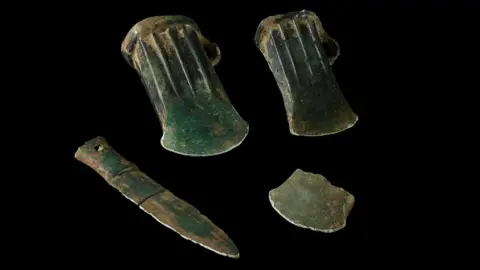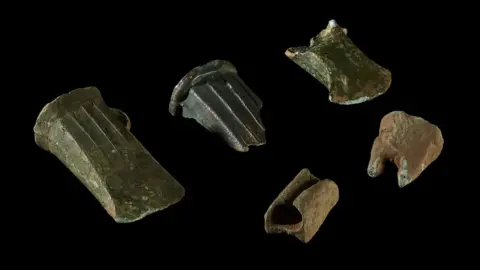Metal detectorists' finds in Wales declared as treasure
 Amgueddfa Cymru – National Museum Wales
Amgueddfa Cymru – National Museum WalesThree treasure finds by metal detectorists in Wales have been officially declared as treasure.
Two Bronze Age hoards were found in Monmouthshire and a silver brooch was discovered in Newport.
Some of the finds include socketed axes with rib decoration on their faces and date back to the 10th Century.
National Museum Wales experts said the finds "add to our understanding of its widespread circulation within medieval Wales".
Two fragments of a bronze socketed knife, two bronze socketed axes with rib decoration on their faces and a blade fragment from another bronze socketed axe were included in a hoard of bronze tools found by Brendan Bishop.
He found them while metal detecting in Monmouth between June 2016 and January 2017.
It is thought they were buried together nearly 3,000 years ago as a religious offering by a community of farmers living nearby.
 Amgueddfa Cymru – National Museum Wales
Amgueddfa Cymru – National Museum WalesThe second Bronze Age hoard of tools was found by Darren Jassett in Llanover in May 2017.
The hoard of five artefacts included two bronze socketed axes with rib decoration, the fragment of a plain bronze socketed axe, a bronze winged axe fragment and a bronze casting jet.
"Bronze Age hoards are one of the many mysteries from prehistory," Monmouthshire Museums curator Anne Rainsbury said.
"There are fascinating theories about why people may have deliberately buried collections of broken, as well as whole bronze axes and other tools.
"The locations of these hoards are being carefully mapped to provide another piece of information in this jigsaw, so these finds are really important."
Each year, between 20 and 45 treasure cases are reported in Wales as finds made by members of the public, with discoveries increasing year-on-year, according to National Museum Wales.
 Amgueddfa Cymru – National Museum Wales
Amgueddfa Cymru – National Museum WalesDr Mark Redknap, from National Museum Wales, believes the decorative medieval brooch inlaid with niello is 13th or 14th Century.
"Worn primarily as dress-fasteners, this particular brooch form has a curved crossbar to prevent snagging of textile," he said, adding similar examples had been found in Abergavenny, the Vale of Glamorgan, Flintshire, Breconshire and on Anglesey.
It was found in January 2019 in Langstone, Newport, by Steve Cashmore with Newport Museum and Art Gallery hoping to acquire the brooch for its collection.
